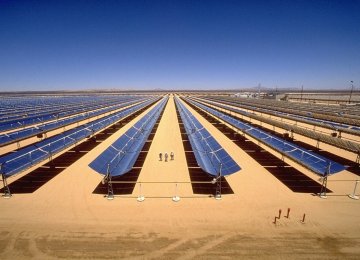On April 6th, several Middle Eastern nations announced an ambitious energy project to establish an Arab Common Market for electricity. The energy ministers from 14 Arab countries signed a memorandum of understanding, confirming their commitment to the development of an integrated electricity supply system for the Middle East.
This announcement is very important, yet it also comes at time of even larger changes in energy in the Middle East: solar power. A future common electricity market will see an ever-increasing role for solar power as countries across the Middle East are heavily investing in renewables, Oil Price reported.
Ongoing low oil prices together with rising demographic concerns are increasingly motivating Middle East and North Africa (MENA) states to invest in a more secure and diversified energy portfolio.
With an estimated population of 692 million by 2050, the MENA region will require a substantial increase in generating capacity to meet future energy demands. This point has been hit home this year as Fitch has warned that most oil producers will not break even in 2017, based on a predicted average price of $52.50 per barrel. Most MENA countries need substantially higher prices. For instance, Saudi Arabia needs $74 to balance their budgets.
Solar investment makes economic and security sense
These fiscal pressures risk instability, both in the short and long-term, not only due to general budgetary concerns, but the risk of energy-related social unrest. Erratic domestic electricity supply has been a main instigator of social unrest in Iraq, Lebanon and Egypt. To this end, a common electricity market and grid would help mitigate localized energy disturbances, aiding both economic and social stability.
Consequently, declining oil reserves, climate change, and hydrocarbon price instability means the Middle East will need to look elsewhere for future energy increases. A prime candidate is solar power, as the world’s deserts receive enough energy in six hours to meet the globe’s annual energy needs.
It appears that MENA governments have taken heed, as “over the past year we have seen huge investment in renewables… It seems clear that this is a trend set to continue as nations in the Middle East strive to reduce their carbon footprints and increase generation capacity,” according to Anita Mathews, director at Informa Energy Group.
In the (Persian) Gulf Cooperation Council alone, which accounts for 47% of MENA generating capacity, some $316 billion worth of investments are needed by 2020.
Investment Opportunities
Across the MENA region, hundreds of billions of dollars’ worth of investment opportunities are emerging, both in solar power production and the wider electricity supply chain.
Consequently, alongside Chinese and Japanese investors, EDF – Europe’s largest energy producer – is looking to acquire renewable assets in the Middle East in order to diversify its primarily nuclear-based portfolio and capitalize on growing market demand. In the (P)GCC, power construction contractor awards increased 14% to $25.5 billion in 2017 over 2016. The highest increase was in Saudi Arabia, which saw a 50% increase to $12.35 billion in contractor awards versus 2016.
This comes as Saudi Arabia launched its first competitive global tender for utility-scale solar power projects in January. Government renewable energy initiatives and smart city development has also boosted the regional cable market, which is expecting consolidated annual growth rates of 8.4% through 2023, leading to the creation of a $12 billion market.
The kingdom has announced its Saudi Arabia Vision 2030 and King Salman Renewable Energy Initiative, and also created the energy, industry & mineral resources ‘super-ministry’ in May 2016 to streamline decision making.
Unlike previous fitful efforts, these latest efforts are different because “they represent the highest level of commitment to renewable energy ever seen from the kingdom,” said Ahmed Nada, Middle East VP at First Solar.
Indeed, the involvement of King Salman and Crown Prince Nayef indicates a proactive Saudi leadership that bodes well for ongoing energy diversification efforts.
Shifting to solar power will also save MENA countries money in energy generation. In Saudi Arabia, currently one-third of the country’s 3 million barrel-per-day oil consumption goes towards energy generation.











Add new comment
Read our comment policy before posting your viewpoints